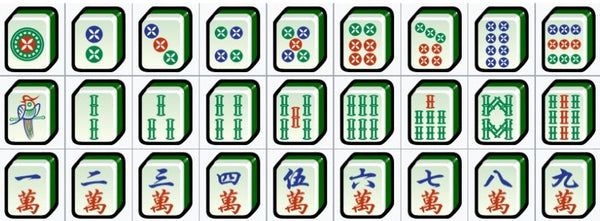It’s established that mahjong originates from ancient China, but its exact origins are uncertain. Over the centuries, the game has undergone many transformations and is likely very different from how it originally started. Before it became known as mahjong, earlier versions of the game went by 麻雀 mah cheuk, which means sparrow. There have also been references to games during the Song and Ming dynasties. During the Song Dynasty (960-1279 AD), a game called Ya Pei was played with wood or ivory tiles, which may contribute to why we play with tiles today. In the Late Ming Dynasty (1368-1644 AD), there was a card trick-playing game called Madiao, which had different suits and involved similar playing strategies. The images on the cards are also said to have inspired the designs on today’s tiles.

Besides these hints to the game’s ancient history, mahjong as we know it likely formed during the mid to late 19th century. Today, there are many different regional style variations such as classic Chinese, Cantonese, Japanese, Korean, Vietnamese, Filipino, American, plus others.
Among the variations, there’s a consensus about how mahjong typically consists of 144 tiles containing three different numbered suits (dots, bamboo, characters), Honors (winds and dragons), and Flowers (flowers and seasons). The tiles are symbolic, just like poker patterns. While gameplay itself has evolved, certain beliefs have also developed around various aspects of the game including setup, tile shuffling, and tile sets. We came across some compelling ideas surrounding mahjong cultural lore and are excited to share them with you.
The Setup
Mahjong involves quite a bit of ritual and that begins with rolling a set of dice to determine the dealer and East wind position for who goes first. This is followed by shuffling tiles or “washing” the tiles 洗牌. The sound is probably one of the first things that comes to mind when people think about mahjong. Many of us grew up watching our relatives play and recall the distinguishable clacking of tiles hitting against one another while jokes and gossip were exchanged. Sometimes, shuffling tiles is referred to as “The Twittering of the Sparrows” for the noise and the chit-chats.

At one point, mahjong in China became linked to corruption. The game was associated with excessive gambling, smoking, and bribery. Rituals around aspects of the game like constructing the tile walls and dealing in a certain fashion were ways to prevent cheating since it was so closely tied to gambling. These negative connotations caused the popularity of mahjong in China to fluctuate throughout the 20th century.
Tile Sets
Mahjong is believed to have evolved from money-suited playing cards, so a common theory is that the dots, bamboo, and character tiles represent cash coins. During the Song, Ming, and Qing dynasties, copper coins had holes in the center and could be strung together in sets. The dot tiles symbolize individual coins while the bamboo tiles represent the strings of coins. The character tile featuring 萬 wàn on its surface means 10,000, referencing tens (of myriads) of coins strung together.

However, if you look at the bamboo suit, you’ll notice the first tile in the suit sequence is a sparrow. If you recall how earlier versions of mahjong were called 麻雀 mah cheuk, you’ll find that this literally translates to the word sparrow. Therefore, an alternate theory, and one that we find especially compelling, is that a game of mahjong is about hunting birds. Bamboo tiles represent the sparrows’ natural habitat while the dots are like gunshots, which is why the game includes sounds and exclamations like “Pong! 碰.” The character tiles with 萬 wàn on its face then depicts the money one gets from shooting the birds. In this same line of thought, the Four Wind tiles are illustrative of the wind directions that affect the gunshot.

Several meanings lend themselves to the Dragon tile set. These tiles are believed to represent three important ideas within ancient Chinese culture, which relate to the Chinese imperial examination, archery, and Confucian virtues. We’re going to focus on the latter two. Throughout Chinese history, archery was an important skill to master. Confucius was an archery teacher himself and it was considered a noble art among emperors. The 中 zhōng tile translates to middle and signifies a hit in archery plus the virtue of benevolence. The 發 fā tile represents wealth or riches, an archer releasing or drawing their bow, and the virtue of trustworthiness. The 白 bái tile meaning blank, illustrates a miss in archery or the Confucian virtue of filial piety. If we apply the hunting birds theory to the Dragon tile set through the lens of firearms and gunshots, it works that 中 zhōng means a hit, 發 fā means many hits (more wealth and riches), and 白 bái means a miss or no hits. The hunting birds theory is likely a newer idea, which perhaps developed as firearms gained in popularity and archery became antiquated.






